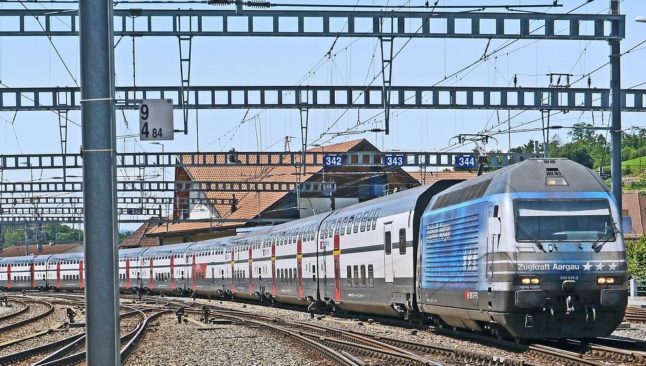The region that will benefit the most by what the SBB calls “the biggest timetable change” in over two decades, is the French-speaking part of the country in the west, which the company previously said will experience fewer direct connections and longer travel times between certain cities due to ongoing construction work.
But faced with criticism from commuters, the SBB changed its strategy.
“The new timetable was created with the input of all the cantons of western Switzerland,” the company said in a press release on Tuesday.
“Even if the service occasionally deteriorates, it provides new direct connections with the west of Lausanne, improvements in regional traffic, as well as reinforced services to the [Vaud] Riviera and Lower Valais in particular.”
And “between Bienne and Geneva, customers benefit from a half-hour rate, subject to a train change in Renens. Direct connections are maintained during peak hours.”
One of the “great new features of the new timetable” is the service to the Lausanne suburb of Renens by certain mainline trains coming from, or going to, other regions of Switzerland.
This will allow some 4,000 commuters bound for western Lausanne each day to get off directly at Renens rather than changing trains at Lausanne station, while it is under construction.
These mainline trains will stop there:
- InterCity IC5 (Rorschach/Zürich–Biel/Bienne–Neuchâtel–Yverdon-les-Bains–Renens–Lausanne, every half hour)
- InterCity IC1 (St-Gallen/Zürich–Berne–Fribourg/Freiburg–Lausanne–Renens–Geneva/Geneva-Airport, every hour)
- InterRegio IR90 (Brig–Sion–Martigny–St-Maurice–Montreux–Lausanne–Renens–Geneva/Geneva-Airport, every hour)
- RegioExpress RE33 (Annemasse–Geneva–Coppet–Nyon–Gland–Rolle–Allaman–Morges–Renens–Lausanne–Vevey–Montreux–Villeneuve–Aigle–Bex–St-Maurice, every half hour and to Martigny, every hour)
“Thanks to the stop at Renens of the IC1 and IR90 trains, passengers will benefit from a new non-stop connection every 30 minutes between Renens and Geneva, with a travel time saving of nine minutes compared to today,” according to the SBB.
“The stop of the IR90 trains also makes it possible to offer a direct link between Valais and Renens every hour; the stop of IC1 trains, a direct connection between Bern, Fribourg/Freiburg and Renens every hour.”
On the other hand, however, following this additional stop in Renens, the shortest journey time between Geneva and Lausanne for mainline trains increases from 35 to 39 minutes.
You can view all the other changes, including on regional lines, here and here.
What about the timetable for the rest of Switzerland?
You can expect these connections in 2025:
- The half-hourly schedule for mainline traffic in the St. Gallen Rhine Valley makes it possible to double the offer for commuters and people traveling for leisure
- As soon as the Gotthard base tunnel is fully recommissioned in September 2024, SBB will be able to introduce the full half-hourly schedule into mainline traffic on the Gotthard axis
- Additional IC5 connections between Eastern Switzerland and Zurich will guarantee a denser pace and more seats
- To relieve congestion at Berne station, an IC connection stops at Berne Wankdorf in the morning and another in the evening during peak hours. Several mainline trains will also stop in Renens in the future. Thanks to the new stops in urban stations, commuters arrive more quickly at their destinations and central stations are relieved of congestion, as is already the case in Zurich with Altstetten and Oerlikon.
- Night connections allow passengers to return home late and travellers to arrive early at Zurich Airport on the Bern–Olten–Zurich main station–Zurich airport section.
And this is what’s in store for international trains:
An additional pair of Zurich–Munich trains will transport passengers (from Monday to Saturday two hours earlier to the Bavarian capital and bring them back in the evening (Monday to Friday and on Sunday) two hours later.
As soon as the Gotthard Base Tunnel is fully in use again in September 2024, direct trains to Bologna and Genoa, as well as the EC Basel–Lucerne–Milan and the tri-national Frankfurt–Zurich–Milan train will operate again .
The direct Zurich–Brig train will now run all year round and will be extended to Domodossola.
Next step
On May 23rd, the Federal Office of Transport (FOT) will initiate the consultation procedure for the proposed timetable.
Any inconsistencies can be reported until June 9th, 2024.
The new timetable will come into force on December 15th, 2024.



 Please whitelist us to continue reading.
Please whitelist us to continue reading.
I hope that account is taken of wheelchair passengers who alight at the middle platform in Villeneuve, as there are no lifts or ramps to exit the platform,- at least not when I travelled last January…I was marooned for quite some time!